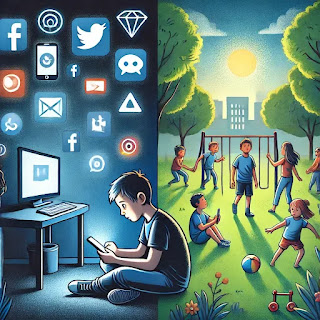Why is too much screen time a problem?
Okay, so screens are fun and can even be helpful. But here's the deal: spending too much time on them can lead to some not-so-fun stuff.
●
Trouble Sleeping: The blue light from screens can make it harder to fall asleep. This is because the blue light messes with a hormone called melatonin that helps you feel sleepy. If you don't get enough sleep, you might feel tired and want to snack more.
●
Weight Gain: When you're watching screens, you’re usually not moving around. This can lead to weight gain. Plus, sometimes when you're watching TV or playing games, you might eat more snacks without even realizing it.
●
Behavior Issues: Spending too much time on screens can make some kids feel more moody, frustrated, or have trouble paying attention. Some studies show that too much screen time can lead to problems with emotions, social skills, and focusing.
●
School Problems: Kids who have TVs or other screens in their bedrooms might not do as well in school. Too much screen time can also mean less time for homework and reading.
●
Less Time for Play: If you’re always on screens, you miss out on playing outside or doing creative things. Playing is super important for learning, making friends, and building your imagination.
How much screen time is okay?
It’s not always about the exact number of hours, but here are some guidelines:
●
Babies and Toddlers (under 2 years): Try to avoid screens, except for video chatting with family.
●
Preschoolers (2-5 years): About one hour a day of good quality programs, like educational shows that you watch with a grown up.
●
Kids and Teens (5-17 years): No more than two hours a day of non-school related screen time, but the quality of what you watch is more important. Remember that these are just guidelines and that you may need to change what works best for your family.
What can we do about it?
Okay, so we know too much screen time isn’t great. So, what can we do? Here are some ideas that I found to be really helpful:
●
Make a Family Plan: It's a great idea to create a plan with your family about when and how you can use screens. You can make rules for when to turn off screens, like before bedtime or during meals. Try to agree on these rules as a family. You could also get a family media contract that everyone signs so that everyone knows what the rules are and will follow them. ●
Have Tech-Free Zones: Make some places at home "no screen zones," like bedrooms, bathrooms, or the dinner table. Read more
●
Choose Good Content: It's important to pick good quality shows, games and apps. Watch with a grown up and talk about what you are watching. It is very helpful if a grown-up checks out the shows, games, and apps before you play them. Sometimes it is better to watch a show on TV than to watch something on YouTube because TV shows have more rules about what they can show.
●
Get Moving: It's important to balance screen time with other fun things. Get outside to play and do sports, dance around, or play some games that make you move.
●
Be an Example: Parents, remember that kids learn from what they see you do! So, try to limit your own screen time too and show them all the fun things you can do instead of being on your phone or computer.
●
Make Screen Time Active: If you are watching a show try to do some exercises during commercials. Play video games that make you move instead of sit still.
●
Listen to Audiobooks: I found it very helpful to listen to audiobooks instead of watching the screen, especially in the car or before bed.
What if your child is having trouble?
If you feel like your child is spending too much time on screens and it’s making you feel bad, that’s okay. It might be time to talk to come up with some strategies to help you find a better balance. If you notice that your children are:
●
Not interested in hanging out with friends or playing sports.
●
Not doing as well in school.
●
Feeling tired, having trouble sleeping or getting headaches
●
Acting different, like being more angry or sad.
●
Thinking about screens all the time.
●
Not taking care of themselves.
These can be signs that they need to cut down on screens. There are some tools that can help you manage screen time. Also, remember that talking to someone can be very helpful if you are having trouble managing your screen time.
Positive Reinforcement
It's important to focus on the positive and reward good behavior when it comes to screen time. Here are some ways to do that:
●
Praise: When kids follow the rules, tell them specifically what they did well. For example, "I like how you turned off the game when I asked you to!"
●
Rewards: You can reward good choices about screen time with privileges, fun activities, or special treats.
●
Quality Time: Spend time together doing things instead of being on screens.
●
Respect the Contract: Be sure to reward children for following the rules of the online safety contract that your family created together.
Final thoughts
It's not all bad! Screens can be great for learning, connecting with friends, and being creative, but it's also important to know that it’s all about finding the right balance. You can use technology in a way that's helpful and fun without it taking over everything. I believe you can do it!





Comments
Post a Comment